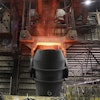The Industrial Product Price Index (IPPI) decreased 0.5 percent in October, mainly because of lower prices for energy and petroleum products. The Raw Materials Price Index (RMPI) declined 4.3 percent in October, largely as a result of lower prices for crude energy products.
Of the 21 major commodity groups, 12 were up, 4 were down and 5 were unchanged.
The decline in the IPPI was led by lower prices for energy and petroleum products (-4.6 percent). This was the largest decline for energy and petroleum products since June 2012. Motor gasoline (-7.2 percent), and, to a lesser extent, light fuel oils (-4.3 percent) and diesel fuel (-3.3 percent), were the main reasons for the decline in this commodity group. The last time motor gasoline decreased to this extent was July 2009 when prices fell 7.2 percent. Growing crude oil supplies and weaker global demand have put downward pressure on prices for refined petroleum products. The IPPI excluding energy and petroleum products increased 0.2 percent in October.
Moderating the decline in the IPPI for October was higher prices for motorized and recreational vehicles (+0.9 percent). The main reason for the gain was higher prices for passenger cars and light trucks (+0.9 percent), motor vehicle engines and motor vehicle parts (+0.9 percent) as well as aircraft (+1.8 percent). The increase in the prices of motorized and recreational vehicles was closely linked to the depreciation of the Canadian dollar relative to the US dollar.
To a lesser extent, chemicals and chemical products (-0.8 percent) also contributed to the decline in the IPPI. Lower prices for petrochemicals (-4.4 percent) was the main reason for the decline in this commodity group, as lower petrochemical feedstock prices have put downward pressure on prices.
Also contributing to the decline in the IPPI was fruit, vegetables, feed and other food products (-0.6 percent). The decrease in this commodity group was mainly due to grain and oilseed products, not elsewhere classified (-4.7 percent) as well as other animal feed (-2.4 percent).
Some IPPI prices are reported in US dollars and are converted to Canadian dollars using the average monthly exchange rate. Consequently, any change in the value of the Canadian dollar relative to the US dollar will affect the level of the index. From September to October, the Canadian dollar depreciated 1.8 percent relative to the US dollar. If the exchange rate had remained constant, the IPPI would have declined 1.0 percent instead of decreasing 0.5 percent.
The IPPI rose 2.5 percent during the 12-month period ending in October, following a 2.6 percent gain in September.
Compared with October 2013, the advance of the IPPI was mainly attributable to motorized and recreational vehicles (+5.1 percent), led by higher prices for passenger cars and light trucks (+5.3 percent), motor vehicle engines and motor vehicle parts (+4.0 percent) and aircraft (+9.8 percent).
Moderating the year-over-year increase in the IPPI was lower prices for energy and petroleum products (-3.7 percent). The decline in this commodity group was mainly due to lower prices for diesel fuel (-8.7 percent), motor gasoline (-2.5 percent) and light fuel oils (-5.0 percent).
Meat, fish, and dairy products (+11.0 percent) also contributed to the year-over-year increase in the IPPI, with higher prices for fresh and frozen beef and veal (+32.4 percent) and fresh and frozen pork (+17.6 percent).
Chemicals and chemical products (+4.5 percent) also contributed to the year-over-year increase of the IPPI, primarily as a result of higher prices for dyes and pigments, and petrochemicals (+9.9 percent), plastic resins (+7.3 percent) as well as fertilizers, pesticides and other chemical products (+4.4 percent).
Raw Materials Price Index
The RMPI fell 4.3 percent in October, following a 2.1 percent decrease in September. It was the fourth consecutive monthly decline and the largest decrease in the index since the 4.4 percent drop in June 2012. Of the six major commodity groups, two were down, three were up and one was unchanged.
The decrease in the RMPI was mainly attributable to lower prices for crude energy products (-8.8 percent), which posted the largest decline since June 2012. Lower prices for conventional crude oil (-8.9 percent) were largely responsible for the decline in this commodity group. The decrease in crude oil prices was partly due to higher crude oil production and a slowdown in world demand. The RMPIexcluding crude energy products rose 0.6 percent in October.
The decline of the RMPI was moderated primarily by prices for animals and animal products, which rose 1.8 percent in October, after two consecutive monthly decreases. The main contributors to the increase in this commodity group were live animals (+2.8 percent), particularly cattle and calves (+3.7 percent) and hogs (+4.0 percent).
The RMPI fell 2.3 percent in the 12-month period ending in October, after declining 1.3 percent in September. On a year-over-year basis, it was the largest decrease in the index since November 2013.
Compared with the same month a year earlier, the decrease in the RMPI was almost entirely attributable to a 9.2 percent drop in the prices of crude energy products. Conventional crude oil (-9.3 percent) was mainly responsible for the decline in this commodity group. The RMPI excluding crude energy products rose 5.6 percent in October.
The decrease in the RMPI over the 12-month period was moderated mainly by higher prices for animals and animal products (+14.3 percent), which have been trending upward on a year-over-year basis since April 2013. Live animals (+24.6 percent), particularly cattle and calves (+43.6 percent) and hogs (+20.2 percent), was primarily the source of the increase in this commodity group.
Compared with the same month a year earlier, the decline of the RMPI was also moderated by prices for metal ores, concentrates and scrap (+1.6 percent), which posted a sixth consecutive year-over-year increase.






















